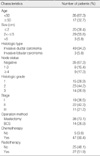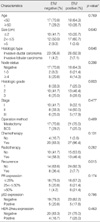Abstract
Purpose
Estrogen receptor (ER) is the key therapeutic target in breast cancer. ERβ has recently been identified to be distinct from ERα. In contrast to ERα, the functions of ERβ in breast cancer are still unclear. We sought to determine whether the expression of ERβ can be used as a predictive marker for endocrine therapy for patients with ERα-negative breast cancer.
Methods
Formalin-fixed, paraffin-embedded tumor specimens from 52 patients with ER-/PR+ invasive breast cancer were immunostained for their ERβ expression. These patients were treated with adjuvant tamoxifen. The results were correlated with various clinicopathological variables and the follow-up data. The expressions of p53 and HER-2/neu were also analyzed and correlated with the ERβ status.
Results
An ERβ expression was observed in 53.8% (28/52) of the breast cancer samples. There was no correlation between the ERβ expression and the other clinicopathologic factors (age, tumor size, histologic type, nodal status, histological grade, stage, therapeutic modality, progesterone receptor (PR) expression, p53 expression and HER-2/neu expression). Recurrence was present in 7.7% (2/26) of the patients whose tumors had an ERβ expression, as compared to the presence of recurrence in 36.4% (8/22) of the patients whose tumors had no ERβ expression (p<0.05). The patients with ERβ negative-tumors revealed lower disease free survival rate than those with ERβ positive-tumors (p<0.05). Of the 52 patients, 10 (19.2%) were p53 positive, and 11 (21.2%) were HER-2/neu positive. No significant correlations were observed between ERβ and p53 or HER-2/neu.
Figures and Tables
 | Figure 1Immunoreactivity for ERβ. (A) In normal breast lobules, the protein expressed in the majority of luminal epithelial cells (×400).
(B) Intense immunoreactivity for ERβ is noted in the nuclei of an invasive ductal carcinoma (×200).
ERβ=estrogen receptor beta.
|
 | Figure 2Kaplan-Meier curves for ERβ expression in breast carcinoma patients. Patients with ERβ negative-tumors suffered a significantly decreased disease free survival (log-rank test, p<0.05).
ERβ=estrogen receptor beta.
|
References
1. Green S, Walter P, Kumar V, Krust A, Bornert JM, Argos P, et al. Human oestrogen receptor cDNA: sequence, expression and homology to v-erb-A. Nature. 1986. 320:134–139.

2. Greene GL, Gilna P, Waterfield M, Baker A, Hort Y, Shine J. Sequence and expression of human estrogen receptor complementary DNA. Science. 1986. 231:1150–1154.

4. Clarke R, Liu MC, Bouker KB, Gu Z, Lee RY, Zhu Y, et al. Antiestrogen resistance in breast cancer and the role of estrogen receptor signaling. Oncogene. 2003. 22:7316–7339.

5. Kuiper GG, Enmark E, Pelto-Huikko M, Nilsson S, Gustafsson JA. Cloning of a novel receptor expressed in rat prostate and ovary. Proc Natl Acad Sci U S A. 1996. 93:5925–5930.

6. Hu YF, Lau KM, Ho SM, Russo J. Increased expression of estrogen receptor beta in chemically transformed human breast epithelial cells. Int J Oncol. 1998. 12:1225–1228.

7. Speirs V, Parkes AT, Kerin MJ, Walton DS, Carleton PJ, Fox JN, et al. Coexpression of estrogen receptor alpha and beta: poor prognostic factors in human breast cancer? Cancer Res. 1999. 59:525–528.
8. Järvinen TA, Pelto-Huikko M, Holli K, Isola J. Estrogen receptor beta is coexpressed with ERalpha and PR and associated with nodal status, grade, and proliferation rate in breast cancer. Am J Pathol. 2000. 156:29–35.

9. Mann S, Laucirica R, Carlson N, Younes PS, Ali N, Younes A, et al. Estrogen receptor beta expression in invasive breast cancer. Hum Pathol. 2001. 32:113–118.

10. Omoto Y, Inoue S, Ogawa S, Toyama T, Yamashita H, Muramatsu M, et al. Clinical value of the wild-type estrogen receptor beta expression in breast cancer. Cancer Lett. 2001. 163:207–212.

11. Shaaban AM, O'Neill PA, Davies MP, Sibson R, West CR, Smith PH, et al. Declining estrogen receptor-beta expression defines malignant progression of human breast neoplasia. Am J Surg Pathol. 2003. 27:1502–1512.

12. Nakopoulou L, Lazaris AC, Panayotopoulou EG, Giannopoulou I, Givalos N, Markaki S, et al. The favourable prognostic value of oestrogen receptor beta immunohistochemical expression in breast cancer. J Clin Pathol. 2004. 57:523–528.

13. Choi Y, Pinto M. Estrogen receptor beta in breast cancer: associations between ERbeta, hormonal receptors, and other prognostic biomarkers. Appl Immunohistochem Mol Morphol. 2005. 13:19–24.

14. Skliris GP, Leygue E, Curtis-Snell L, Watson PH, Murphy LC. Expression of oestrogen receptor-beta in oestrogen receptor-alpha negative human breast tumours. Br J Cancer. 2006. 95:616–626.

15. Hopp TA, Weiss HL, Parra IS, Cui Y, Osborne CK, Fuqua SA. Low levels of estrogen receptor beta protein predict resistance to tamoxifen therapy in breast cancer. Clin Cancer Res. 2004. 10:7490–7499.

16. Myers E, Fleming FJ, Crotty TB, Kelly G, McDermott EW, O'higgins NJ, et al. Inverse relationship between ER-beta and SRC-1 predicts outcome in endocrine-resistant breast cancer. Br J Cancer. 2004. 91:1687–1693.

17. Borgquist S, Holm C, Stendahl M, Anagnostaki L, Landberg G, Jirström K. Oestrogen receptors alpha and beta show different associations to clinicopathological parameters and their co-expression might predict a better response to endocrine treatment in breast cancer. J Clin Pathol. 2008. 61:197–203.

18. Gruvberger-Saal SK, Bendahl PO, Saal LH, Laakso M, Hegardt C, Edén P, et al. Estrogen receptor beta expression is associated with tamoxifen response in ERalpha-negative breast carcinoma. Clin Cancer Res. 2007. 13:1987–1994.

19. Baek JM, Sung GY, Lee DS, Chun KH, Lee DH, Seo YJ, et al. Expression of estrogen receptor beta, estrogen receptor alpha and cyclooxygenase II in advanced breast cancer. J Breast Cancer. 2005. 8:45–51.

20. Kim SI, Park SO, Jung SY, Yang WI, Park BW. Comparison of estrogen receptor beta expression between breast cancer and normal mammary tissue and relationship with clinicopathological factors. J Breast Cancer. 2005. 8:99–104.

21. Association of Directors of Anatomic and Surgical Pathology. Recommendations for the reporting of breast carcinoma. Hum Pathol. 1996. 27:220–224.
22. Greene FL, Page DL, Fleming ID, Fritz AG, Balch CM, Haller DG, et al. AJCC Cancer staging manual. 2002. 6th ed. New York: Springer-Verlag;223.
23. Lee JS, Kim HS, Jung JJ, Lee MC, Park CS. Expression of vascular endothelial growth factor in adenocarcinomas of the uterine cervix and its relation to angiogenesis and p53 and c-erbB-2 protein expression. Gynecol Oncol. 2002. 85:469–475.

24. Roger P, Sahla ME, Mäkelä S, Gustafsson JA, Baldet P, Rochefort H. Decreased expression of estrogen receptor beta protein in proliferative preinvasive mammary tumors. Cancer Res. 2001. 61:2537–2541.
25. Skliris GP, Parkes AT, Limer JL, Burdall SE, Carder PJ, Speirs V. Evaluation of seven oestrogen receptor beta antibodies for immunohistochemistry, western blotting, and flow cytometry in human breast tissue. J Pathol. 2002. 197:155–162.

26. Clarke R, Liu MC, Bouker KB, Gu Z, Lee RY, Zhu Y, et al. Antiestrogen resistance in breast cancer and the role of estrogen receptor signaling. Oncogene. 2003. 22:7316–7339.

27. Early Breast Cancer Trialists'Collaborative Group. Systemic treatment of early breast cancer by hormonal, cytotoxic, or immune therapy. 133 randomised trials involving 31,000 recurrences and 24,000 deaths among 75,000 women. Lancet. 1992. 339:1–15.
28. Early Breast Cancer Trialists'Collaborative Group. Tamoxifen for early breast cancer: an overview of the randomised trials. Lancet. 1998. 351:1451–1467.




 PDF
PDF ePub
ePub Citation
Citation Print
Print







 XML Download
XML Download